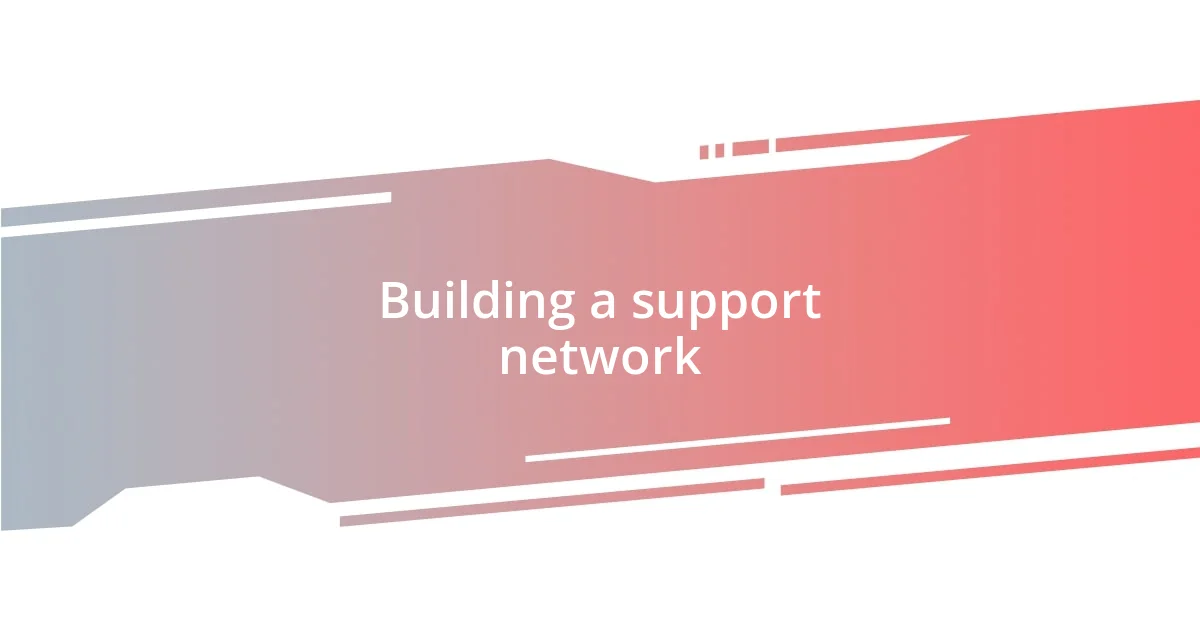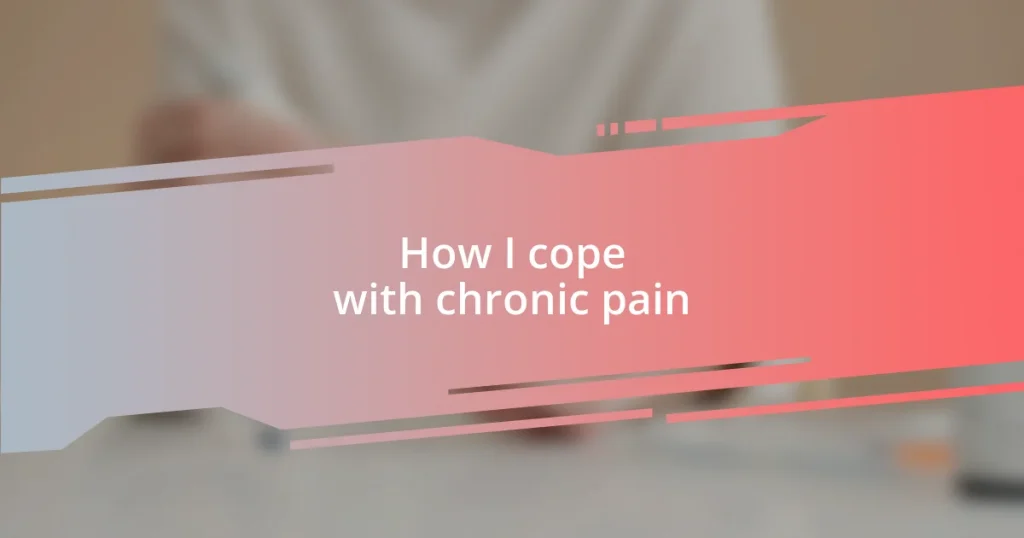Key takeaways:
- Understanding chronic pain involves recognizing its biopsychosocial aspects and exploring holistic approaches like mindfulness and emotional processing.
- Identifying pain triggers, such as weather changes, stress, and diet, is crucial for effective pain management and relief strategies.
- Building a strong support network through professional help and community connections significantly enhances coping strategies and emotional resilience.

Understanding chronic pain
Chronic pain is often described as a persistent ache that doesn’t go away, and I can deeply relate to this feeling. Imagine waking up every day with a dull throb that colors your every thought and action—it can be exhausting. This ongoing discomfort can influence not only physical health but also emotional well-being, sometimes leading to feelings of frustration and isolation.
I remember when my chronic pain first started; it felt like a relentless shadow following me everywhere. Have you ever tried to explain your invisible struggle to someone who simply doesn’t understand? The sensation of aching joints and tired muscles can weigh heavily on your spirit, making it challenging to engage in activities that once brought joy.
Understanding the biopsychosocial model of chronic pain has been a game changer for me. It emphasizes that pain is not just a physical sensation but is intertwined with psychological and social factors. This realization led me to explore mindfulness techniques and deeper emotional processing, allowing me to reclaim some control over my pain management. Do you find that taking a holistic approach can shift your perspective on living with chronic discomfort? It certainly has for me.

Recognizing pain triggers
Recognizing pain triggers is a crucial step in managing chronic pain effectively. I’ve learned to pay close attention to my body’s signals, which often indicate what could set off my discomfort. For instance, I notice that sudden changes in weather can lead to increased joint pain. It’s fascinating how something as seemingly innocuous as humidity can have such a profound effect on my day-to-day life.
Through my journey, I’ve also discovered that stress plays a significant role in amplifying pain. When I’m overwhelmed or anxious, I can almost feel the tightness creep into my muscles. Have you ever felt how your emotional state can directly impact your physical sensations? For me, practicing relaxation techniques like deep breathing has become essential in alleviating this added tension before it becomes debilitating.
Sometimes, it’s the little things that become the biggest triggers. I’ve found that certain foods, particularly those high in sugar or processed ingredients, can lead to inflammation and, consequently, pain flare-ups. Keeping a detailed food journal has not only helped me identify these patterns but also empowered me to make changes that are beneficial for my overall well-being and pain management.
| Trigger | Effect on Pain |
|---|---|
| Weather Changes | Increased joint discomfort |
| Stress | Muscled tightness and pain amplification |
| Diet (sugar, processed foods) | Inflammation leading to flare-ups |

Effective pain management techniques
Effective pain management techniques have become essential tools in my daily routine. Over the years, I’ve found that combining both physical and mental strategies not only helps alleviate pain but also boosts my overall quality of life. For example, engaging in regular gentle exercises, like yoga or swimming, has significantly improved my flexibility and strength, making everyday activities a bit more bearable. But it’s not all physical; I’ve also incorporated practices like mindfulness meditation, which helps me create a mental buffer against my discomfort.
- Mindfulness meditation to enhance mental resilience.
- Gentle exercises, such as yoga or swimming, for physical strength.
- Heat therapy, like a warm bath or heating pad, to relax tense muscles.
- Scheduled rest periods to avoid overexertion and promote recovery.
- Sharing experiences with support groups for emotional support and understanding.
Adding to my pain management toolbox, I’ve embraced the benefits of cognitive behavioral therapy (CBT). Adopting this approach has helped me rewrite the narrative surrounding my pain; instead of feeling victimized by it, I now focus on developing coping strategies tailored to my life. For instance, I’ve learned to challenge negative thoughts, which can amplify my suffering. I’d love to hear if you’ve tried anything similar—like reframing your mindset—because it has genuinely transformed how I cope with daily discomfort.

Incorporating physical activity
Incorporating physical activity into my daily routine has been an enlightening journey. I remember the first time I ventured into a gentle morning walk, determined to combat the stiffness in my joints. Surprisingly, not only did I feel a rush of endorphins, but that fresh morning air also provided a mental clarity I didn’t know I needed. Have you ever noticed how even a small amount of movement can shift your mood in unexpected ways?
Yoga has played a pivotal role in my life as well. At first, I was hesitant, thinking my pain would hold me back, but I discovered that even simple stretching greatly increased my flexibility. One afternoon, while practicing a gentle flow, the tension I usually carried in my shoulders began to melt away. It was a vivid reminder of how movement, even when gentle, can be incredibly therapeutic. Have you experienced that lightness after a good stretch?
Now and then, I challenge myself to try new activities, like swimming or even dancing in my living room. These moments are lighthearted, and honestly, it’s the joy that makes all the difference. I’ve found that when I’m focused on enjoying the activity rather than the discomfort, I often forget about the pain altogether. Isn’t it fascinating how the right mindset can turn exercise into a joyful experience rather than a chore?

Utilizing mindfulness practices
Utilizing mindfulness practices has opened up a new realm of coping strategies for me. I was skeptical at first; the idea of sitting still and focusing on my breath felt counterintuitive when my body was screaming for relief. However, in those quiet moments of mindfulness meditation, I found an unexpected refuge. There have been times when I have felt a wave of pain crashing over me, and instead of spiraling into despair, I learned to observe it, creating space between the sensation and my emotional reaction. Isn’t it extraordinary how simply being present can change your perception of pain?
One particularly tough day stands out in my memory. I sat down for my usual mindfulness session, feeling overwhelmed and tense. Instead of ignoring the discomfort, I focused on it, breathing into the pain as if to invite it in rather than reject it. As I did this, I noticed that the intensity lessened; it was almost as if acknowledging it took away some of its power. By practicing mindfulness, I’ve not only learned to track my pain but also to navigate my emotions surrounding it. How often do we overlook our pain because we’re afraid to confront it?
Incorporating mindfulness into my daily routine has become a game changer. It’s fascinating how a few minutes of mindfulness can set a positive tone for my day. I love taking a moment in the morning to pause and center myself before diving into daily tasks. This practice has helped me cultivate an inner strength that doesn’t fade when I encounter discomfort. Have you tried weaving mindfulness into your day, and if so, how has it reshaped your relationship with pain? I genuinely believe that creating this mental space has fostered a resilience that bolsters my ability to cope.

Seeking professional support
Seeking professional support has been an important step in my journey with chronic pain. I recall sitting nervously in a doctor’s office, feeling vulnerable as I shared my experiences. To my surprise, the doctor not only validated my feelings but also laid out a variety of treatment options. Have you ever felt that relief when someone truly understands what you’re going through?
Finding a therapist who specializes in pain management was another game changer for me. During our sessions, I learned valuable coping strategies tailored to my unique situation. There was a moment when I shared my frustration about feeling misunderstood by friends and family. My therapist gently guided me through techniques to communicate my needs better, which fundamentally changed how I interacted with loved ones. Isn’t it fascinating how professional support can illuminate paths we hadn’t even considered?
Group therapy sessions have also broadened my perspective. The first time I attended, I was taken aback by how many people faced similar challenges. Sharing my experiences in that safe space not only provided comfort but strengthened my resolve. Hearing stories of resilience from others instilled hope in me, reminding me that I’m not alone on this journey. Have you ever felt empowered just by connecting with others who understand your struggles?

Building a support network
Building a support network is essential in navigating the challenges of chronic pain. I remember the first time I reached out to friends and family about my experiences; it felt daunting. I hesitated, worried they wouldn’t understand, but when I opened up, I was met with compassion and a willingness to help. Isn’t it remarkable how vulnerability can sometimes forge stronger bonds?
I found that joining local support groups was a transformative experience. The first meeting left me feeling strangely comforted, surrounded by others who truly “got it.” As we shared our stories, I felt a sense of freedom in expressing my struggles without judgment. It’s a relief to know that there are people who can relate to the unique daily battles I face. Have you ever felt the power of shared experiences in healing?
Moreover, leveraging social media to connect with others living with chronic pain has also enriched my support network. I joined a few online communities where I could share insights, seek advice, and simply vent when necessary. One post about a particularly tough week received an outpouring of support that left me feeling genuinely uplifted. It’s incredible how a few encouraging words can make a world of difference. When was the last time you connected with someone who understood your journey?















